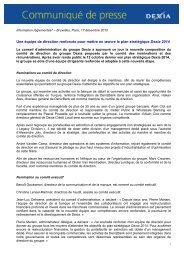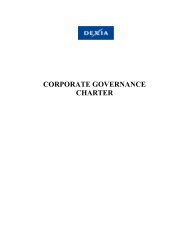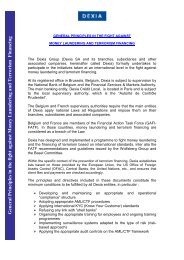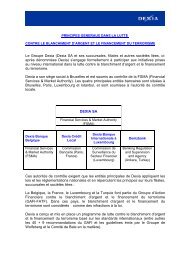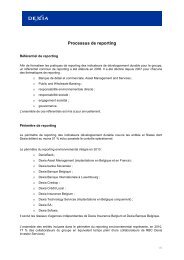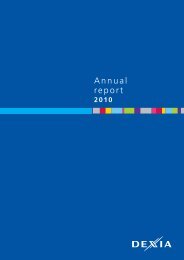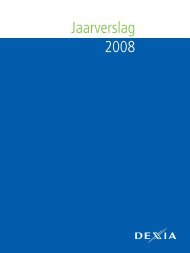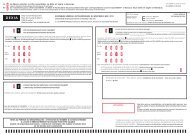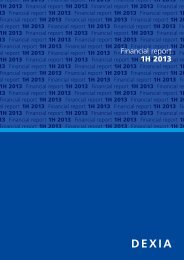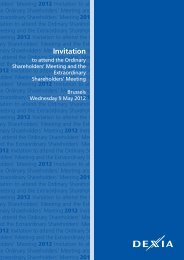Annual report 2006 - Dexia.com
Annual report 2006 - Dexia.com
Annual report 2006 - Dexia.com
You also want an ePaper? Increase the reach of your titles
YUMPU automatically turns print PDFs into web optimized ePapers that Google loves.
Regarding reserves for the files already opened <strong>Dexia</strong> performs<br />
runoff calculations, using estimates for the claims handling<br />
expenses.<br />
For the assessment of loss burden for the insurance portfolio,<br />
<strong>Dexia</strong> conducts a reasoning that is based on percentages<br />
(average loss burden of the last 5 years and administrative<br />
expenses of the last year).<br />
FSA activities<br />
Financial guaranty insurance generally provides an unconditional<br />
and irrevocable guaranty that protects the holder of<br />
a financial obligation against non-payment of principal and<br />
interest when due. Upon a payment default on an insured<br />
obligation, <strong>Dexia</strong> is generally required to pay the principal,<br />
interest or other amounts due in accordance with the obligation’s<br />
original payment schedule or, at its option, to pay<br />
such amounts on an accelerated basis. The contract may be<br />
considered a derivative or an insurance contract depending<br />
on certain legal characteristics.<br />
Gross and ceded premiums received in upfront payouts are<br />
earned in proportion to the amount of risk outstanding over<br />
the expected period of coverage. Deferred premium revenue<br />
and prepaid reinsurance premiums represent the portion of<br />
premium that is applicable to coverage of risk to be provided<br />
in the future on policies in force.<br />
<strong>Dexia</strong> establishes provisions for losses liabilities based on its<br />
estimate of specific and non-specific losses. <strong>Dexia</strong> also establishes<br />
provisions for loss adjustment expenses (LAE), consisting<br />
of the estimated cost of settling claims, including legal<br />
and other fees and expenses associated with administering<br />
the claims process. <strong>Dexia</strong> calculates a loss and loss adjustment<br />
expenses liability based upon identified risks inherent<br />
in its entire insured portfolio. If an individual policy risk has a<br />
probable loss as of the balance sheet date, a specific reserve<br />
is established. For the remaining policy risks in the portfolio, a<br />
non-specific reserve is established to account for the inherent<br />
credit losses that can be statistically estimated.<br />
<strong>Dexia</strong> establishes a specific reserve for the present value of<br />
the estimated loss, net of subrogation recoveries, when, in<br />
management’s opinion, likelihood of a future loss on a particular<br />
insured obligation is probable and reasonably estimable<br />
at the balance sheet date. When an insured obligation has<br />
met the criteria for establishing a specific reserve and that the<br />
transaction pays a premium in installments, those premiums,<br />
if expected to be received prospectively, are considered a form<br />
of recovery and are no longer earned as premium revenue.<br />
A specific reserve is determined using cash flow or similar<br />
models that represent <strong>Dexia</strong>’s estimate of the net present<br />
value of the anticipated shortfall between:<br />
• scheduled payments on the insured obligation plus anticipated<br />
loss adjustment expenses; and<br />
• anticipated cash flow from and proceeds to be received on<br />
sales of any collateral supporting the obligation and other<br />
anticipated recoveries.<br />
The estimated loss, net of recovery, on a transaction is discounted<br />
using the risk-free rate appropriate for the term of<br />
the insured obligation at the time the reserve is established.<br />
<strong>Dexia</strong> records a non-specific reserve to reflect the credit<br />
risks inherent in its portfolio. Non-specific reserves in addition<br />
to specific reserves represent <strong>Dexia</strong>’s estimate of the<br />
total reserves. Generally, when an insured credit deteriorates<br />
to a point where claims are expected, a specific reserve is<br />
established.<br />
The non-specific reserve amount established considers all levels<br />
of protection (e.g., reinsurance and over-collateralization).<br />
Net par outstanding for policies originated in the current<br />
period is multiplied by loss frequency and severity factors.<br />
The loss factors used for calculation are the product of default<br />
frequency rates obtained from Moody’s and severity factors<br />
obtained from S&P. Moody’s is chosen due to its credibility,<br />
large population, statistical format and reliability of future<br />
update. <strong>Dexia</strong> applies an experience factor to the results of<br />
the statistical calculation.<br />
Liability Adequacy Test<br />
An insurer applies a Liability Adequacy Test for its insurance<br />
products, in accordance with IFRS 4. <strong>Dexia</strong> assesses at each<br />
<strong>report</strong>ing date whether its recognized insurance liabilities are<br />
adequate, using current estimates of future cash flows under<br />
its insurance contracts. This test is applied to all insurance<br />
contracts.<br />
For nonlife insurance, the Liability Adequacy Test is a sufficiency<br />
test within IFRS 4 that examines if the premium and<br />
provisions are sufficient to cover any open claim files and<br />
claims that are expected to occur within the contractual duration<br />
of the contracts.<br />
1.11.2. Reinsurance<br />
<strong>Dexia</strong>’s reinsurance contracts with third parties that contain<br />
enough characteristics to be classified as an insurance contract<br />
continue to be accounted for in accordance with local GAAP.<br />
A reinsurance asset is impaired if, and only if:<br />
• there is objective evidence, as a result of an event that<br />
occurred after initial recognition of the reinsurance asset, that<br />
the cedant may not receive all amounts due to it under the<br />
terms of the contract; and<br />
• that event has a reliably measurable impact on the amounts<br />
that the cedant will receive from the reinsurer.<br />
To measure the solvency of a reinsurer, <strong>Dexia</strong> refers to its<br />
attributed credit rating and the impairment rules.<br />
1.12. NETWORK COSTS<br />
This heading records <strong>com</strong>mission paid to intermediaries associated<br />
by exclusive sales mandate for bringing in transactions<br />
with customers.<br />
RAPPORT DE GESTION<br />
CONSOLIDATED<br />
FINANCIAL STATEMENTS<br />
COMPTES SOCIAUX<br />
<strong>Dexia</strong> / <strong>Annual</strong> Report <strong>2006</strong> | 125



